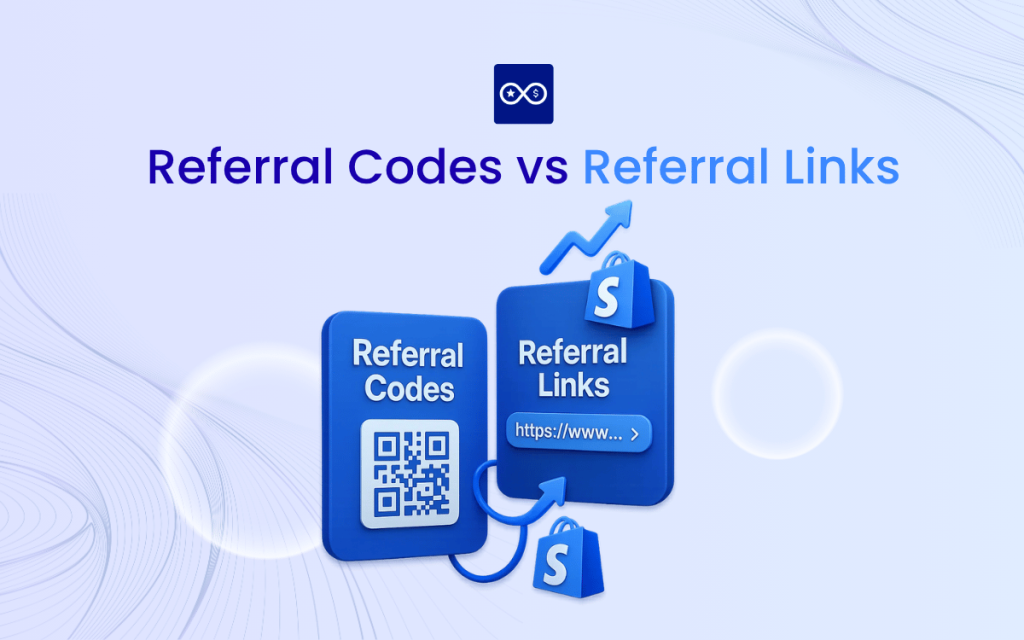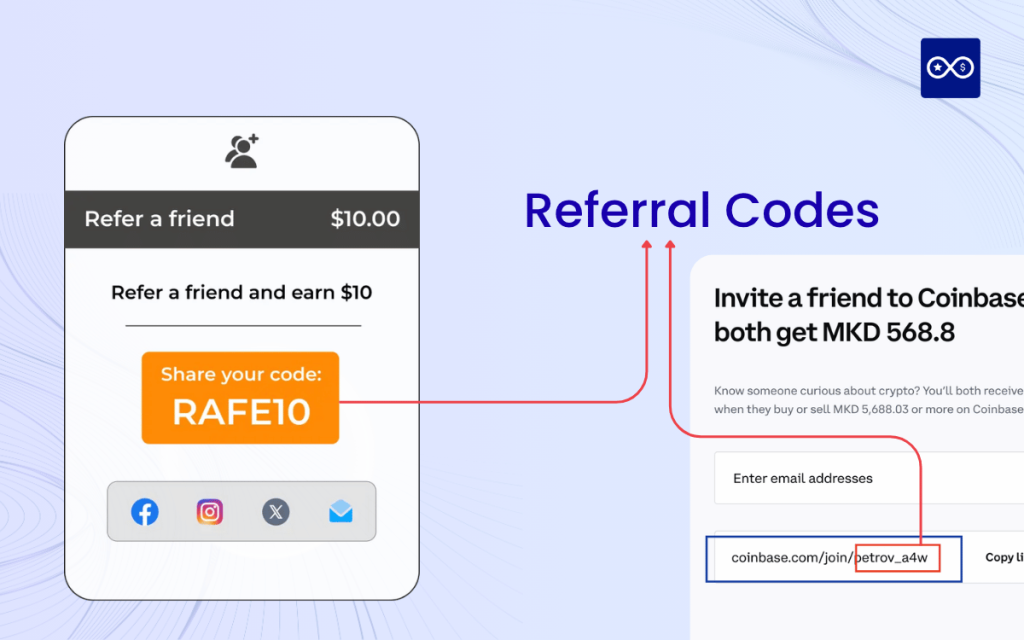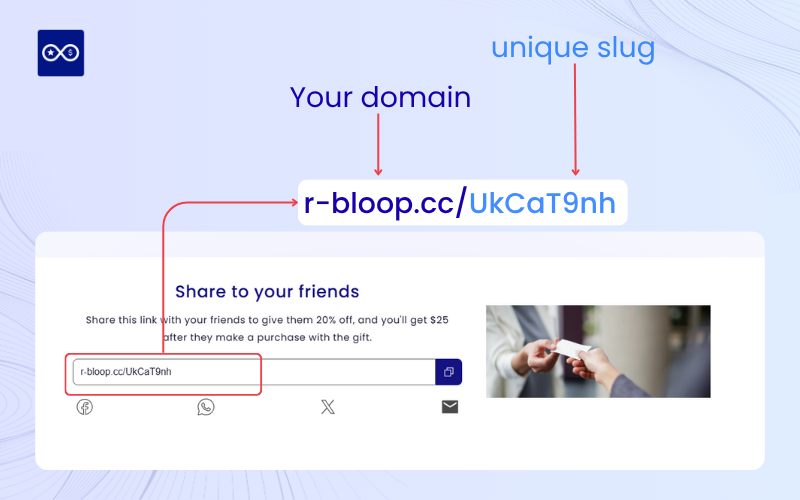Referral Codes vs Referral Links: Which Drives More Shopify Sales in 2026

Referral codes and referral links both turn your customers into marketers, but they work in fundamentally different ways at checkout—one requires typing, the other works with a single click. That difference might seem small, but it directly impacts conversion rates, tracking accuracy, and how much revenue your referral program actually generates.
This guide breaks down how codes and links work in Shopify, compares their performance across mobile, fraud prevention, and attribution, and shows you exactly when to use each format based on your store’s goals. You’ll also get seven proven tactics to maximize sales regardless of which method you choose, plus answers to the questions most merchants ask before launching their referral programs.
What Is A Referral Code And How It Works In Shopify
A referral code is a unique string of letters and numbers—like “SARAH20” or “FRIEND15″—that customers share with friends who then type it in at checkout to unlock a reward. When someone enters that code during purchase, Shopify recognizes it through the discount system and applies the predetermined incentive, whether that’s 15% off, free shipping, or $10 store credit. The platform logs which code was used on each order, connecting the sale back to the original referrer so you can credit them with cash, points, or their own discount.
Codes work best when you keep them short and memorable since people often share them verbally or through text messages. Shopify merchants generate these codes through their admin panel or a referral app, setting rules like minimum order values, expiration dates, and usage limits. The simplicity here is the real advantage—no special technology required, just a string of characters that travels from one person to another.

What Is A Referral Link And How It Works In Shopify
A referral link is a unique URL with tracking parameters—something like “yourstore.com/?ref=sarah123″—that automatically attributes visits and purchases to the person who shared it. When a friend clicks that link, Shopify or your referral app drops a cookie in their browser or logs the session through URL parameters, creating an invisible connection between the click and any future purchase. If that visitor converts within the tracking window (typically 30 to 90 days), the system credits the referrer without the customer typing anything at checkout.
Links excel at frictionless sharing because they work with a single tap across email, social media, messaging apps, and even QR codes. The tracking mechanism relies on cookies or browser fingerprinting, which means the technology handles attribution automatically. This automation makes links particularly powerful for mobile shoppers who’d rather tap than type, and it delivers cleaner data since each link ties to one specific advocate.

Referral Code Vs Referral Link Key Differences At Checkout
The checkout experience reveals the sharpest contrast between codes and links, directly impacting conversion rates and customer satisfaction.
Speed Of Redemption
Referral codes add an extra step at checkout where customers hunt for the discount field, type in the code, and hope they didn’t mistype a character. Links skip this entirely—the discount or tracking applies automatically the moment someone clicks through, shaving precious seconds off the purchase journey. Even one additional form field can drop conversion rates, making that code entry box a potential revenue leak.
Mobile Friendliness
On smartphones, typing codes becomes a frustrating dance of autocorrect battles and tiny keyboards, especially for longer strings. Links work with a single tap, aligning perfectly with how people actually use their phones to shop and share. Since mobile commerce now represents over 70% of e-commerce traffic, any friction on small screens translates to abandoned carts and lost referral opportunities.
Attribution Accuracy
Links offer precise tracking because they capture the exact source, timestamp, and customer journey from click to purchase through URL parameters and session data. Codes can get messy—they’re often shared on public forums, deal sites, or group chats where the original referrer loses credit. While links occasionally break with cross-device shopping (someone clicks on mobile but buys on desktop), modern referral platforms use email matching and extended windows to reconnect those dots.
Discount Stacking Rules
Shopify’s native discount system allows only one discount code per order, which means if a customer has a seasonal promo code and a referral code, they’re forced to choose. Links can work around this limitation by applying rewards as automatic discounts or post-purchase credits, giving you more flexibility in how incentives combine. Setting clear stacking rules prevents customer confusion and support headaches, especially during peak sales periods when multiple promotions overlap.
Pros And Cons Of Referral Codes For Online Stores
Referral codes bring familiarity and flexibility but carry risks that can undermine program performance.
Lower Tech Barrier
Customers already understand coupon codes from years of online shopping, so there’s zero learning curve when you introduce referral codes. This familiarity means higher adoption rates among less tech-savvy audiences who might hesitate with unfamiliar link-sharing mechanics. You can launch a code-based program with just Shopify’s built-in discount features, no additional apps or integrations required.
Susceptible To Leakage
Codes spread beyond your intended audience—they show up on RetailMeNot, Reddit threads, and Facebook groups where strangers use them without any connection to the original referrer. This “code leakage” costs you money in discounts while giving zero referral credit to your advocates, essentially turning your referral program into a generic coupon campaign. Monitoring deal sites and setting aggressive usage limits helps, but it’s an ongoing battle that links largely avoid.
Enables Offline Sharing
When customers chat about your store at dinner parties, yoga classes, or family gatherings, they can easily share a code verbally without pulling out phones or sending links. This offline-to-online bridge matters for brands with strong community presence or brick-and-mortar touchpoints where word-of-mouth happens face-to-face. You can even print codes on receipts, packaging inserts, or business cards, extending your referral reach into physical spaces where links would be impractical.
Pros And Cons Of Referral Links For Online Stores
Links deliver automation and precision but depend on technology that doesn’t always play nice with how real people shop.
One Click Tracking
Links eliminate manual work for both customers and your analytics team—everything from the initial click to the final purchase gets logged automatically without human intervention. This automation lifts conversion rates because there’s no chance of typos, forgotten entries, or “I’ll use it later” procrastination. Your referral dashboard fills with clean data showing exactly which advocates drive the most valuable customers.
Higher Social Share Rates
Social platforms and messaging apps are designed for link sharing—one tap on a share button, and the referral instantly spreads across Instagram stories, WhatsApp groups, or Twitter threads. Links also preview beautifully with custom images and descriptions when shared, making them more visually appealing and clickable than a random string of letters and numbers. This native integration with how people communicate online can double or triple your referral reach compared to asking customers to manually copy and paste codes.
Breaks When Customers Switch Devices
The challenge with link-based tracking is the cross-device shopper who clicks your link on their phone during lunch but completes the purchase on their laptop at home. Cookie-based attribution fails here unless your referral platform uses backup methods like email matching or server-side tracking to reconnect the dots. While this affects a portion of referrals depending on your audience, it’s worth acknowledging and planning for with hybrid approaches or extended attribution windows.
When To Use Codes Vs Links Based On Your Store Goals
Your choice between codes and links aligns with your specific business model, customer behavior, and growth objectives rather than following what competitors do.
High AOV Product Lines
For luxury items, furniture, or anything over $200, customers expect a smooth, premium checkout experience where convenience matters. Links work better here because they maintain that polished feel while codes can seem discount-focused, potentially devaluing your brand perception. The higher your average order value, the more each percentage point of conversion rate improvement translates to actual revenue.
Subscription Businesses
Recurring revenue models benefit from codes because they create explicit, trackable relationships between referrer and subscriber that persist across billing cycles. Many subscription platforms struggle with link attribution after the first payment, but codes tied to customer accounts maintain that connection month after month. This matters when you’re paying ongoing commissions or want to track lifetime value by referral source accurately.
Brick And Mortar Plus Online
Omnichannel retailers where customers discover products in-store but purchase online thrive with codes that bridge those environments naturally. Your sales associates can write codes on business cards, mention them during checkout, or include them in shopping bags without needing customers to scan QR codes or type URLs. Links still play a role here through QR codes on signage or receipts, but codes offer more versatility across the full customer journey.
Preventing Fraud And Coupon Leakage In Shopify
Referral programs attract bad actors who game the system for free rewards, but smart safeguards protect your margins without punishing legitimate advocates.
Block Duplicate Emails
The simplest fraud tactic involves customers creating multiple accounts with slightly different email addresses to refer themselves repeatedly for rewards. Shopify’s customer matching and referral apps can flag variations like sarah@gmail.com and sarah.smith@gmail.com as duplicates, preventing self-referral abuse. Set rules that require unique shipping addresses, payment methods, or phone numbers for each new customer to add extra verification layers.
Auto-Expire Single Use Codes
Time limits and usage restrictions turn codes from evergreen coupons into targeted referral tools that can’t be stockpiled or shared indefinitely. Configure your codes to expire after 30 to 60 days and limit them to one use per customer, forcing advocates to generate fresh codes for each friend rather than blasting old ones across the internet. Order minimums also help by ensuring referral discounts only apply to substantial purchases, not test orders designed to game rewards.
Flag Unusual Order Patterns
Watch for red flags like multiple orders to the same address with different names, bulk purchases immediately after account creation, or sudden spikes in referral activity from a single advocate. Modern referral platforms include velocity checks that pause suspicious accounts for manual review before issuing rewards, catching fraud before it costs you money.
Can You Run Codes And Links Together Without Messy Data
Hybrid referral programs offer customers choice while giving you the best of both worlds, but they require careful setup to avoid attribution chaos.
Map Both To Same Reward Logic
Whether someone uses code “FRIEND20” or clicks a referral link, the reward structure stays consistent—say, 20% off for the new customer and $10 credit for the referrer. Mismatched incentives between methods confuse customers and create perceived unfairness when advocates compare notes. Your referral platform treats codes and links as two paths to the same outcome, not separate programs competing for attribution.
Deduplicate In Shopify Analytics
When a customer clicks a referral link but then manually enters a code at checkout, you risk double-counting that conversion or worse, crediting the wrong referrer. Smart deduplication rules prioritize one method (typically “last touch wins”) and use email matching to ensure each sale credits only one advocate. Set up your analytics to merge these touchpoints into a single customer journey view rather than treating them as independent events.
Use Hybrid QR Codes
QR codes printed on packaging, receipts, or marketing materials encode referral links while feeling as simple as codes to customers who just scan and go. This bridges the offline sharing advantage of codes with the automated tracking precision of links, giving you accurate attribution even when referrals start in physical spaces. A customer might scan a QR code at a pop-up shop, which loads a referral link on their phone, combining the best aspects of both approaches seamlessly.
| Feature | Referral Codes | Referral Links | Hybrid QR |
| Ease of Use | Moderate (typing required) | High (one-click) | High (scan and go) |
| Tracking Accuracy | Medium (prone to leakage) | High (session-based) | High (link-encoded) |
| Fraud Prevention | Moderate (usage limits help) | High (device fingerprinting) | High (link controls) |
| Mobile Performance | Low (typing friction) | High (tap-friendly) | High (camera native) |
| Offline Viability | High (verbal sharing) | Low (needs digital share) | High (print anywhere) |
Seven Best Practices To Maximize Sales From Any Referral Format
These tactics work whether you choose codes, links, or a hybrid approach, focusing on the fundamentals that drive referral program success.
1. Offer Double-Sided Rewards
Incentivize both the referrer and their friend with meaningful rewards—say, $15 credit for the advocate and 15% off for the new customer—to boost participation on both ends. Single-sided programs where only one party benefits see lower engagement because there’s less motivation for the friend to actually complete their purchase.
2. Keep Sharing One Click
Whether customers are generating a code or grabbing a link, the process takes under 5 seconds from your referral dashboard or post-purchase page. Pre-fill share messages with compelling copy, make copy buttons obvious, and offer multiple sharing channels like email, SMS, WhatsApp, and Facebook so advocates choose their preferred method.
3. Promote In Post-Purchase Emails
Trigger referral invites when satisfaction peaks—right after delivery confirmation or a positive review—rather than immediately at checkout when customers are still evaluating their decision. This timing catches people in their “I love this” moment when they’re most likely to share. Include the referral code or link directly in the email so sharing requires zero extra steps.
4. Highlight Social Proof Widgets
Display recent referral activity, testimonials from successful advocates, and participation counts on your referral landing page to build trust. Seeing “Sarah just earned $45 in rewards” or “2,847 customers have joined through referrals” makes the program feel active and legitimate rather than a forgotten feature.
5. Test Incentive Sizes Quarterly
Optimize reward amounts based on your customer acquisition cost, payback period, and lifetime value by cohort rather than setting them once and forgetting. Run A/B tests comparing $10 versus $15 rewards or 15% versus 20% discounts to find your program’s sweet spot where participation and profitability intersect.
6. Reward Advocates Fast
Approve and deliver rewards within 24 to 48 hours of a successful referral to reinforce the behavior while it’s fresh and encourage repeat sharing. Delayed or complicated reward redemption kills momentum—if advocates wait weeks for credits or jump through hoops to claim earnings, they’ll stop referring regardless of incentive size.
7. Monitor And Optimize Performance
Track metrics that matter beyond just “number of referrals” to understand program health and identify improvement opportunities.
Key metrics by method:
- Codes: Redemption rate (uses divided by shares), unique code uses, leak incidence on deal sites, discount stacking conflicts
- Links: Click-to-order conversion rate, cookie attribution window performance, cross-device loss rate, assisted conversions
- Hybrid: Deduplication success rate, share channel mix (QR versus social versus email), fraud flags per method
>> You may also like: Top 7 Referral Widgets for Shopify That Actually Drive Conversions
FAQs About Referral Codes And Links
How much does it cost to implement a hybrid referral program?
Most Shopify referral apps price by order volume or monthly revenue rather than the number of referral methods you enable, so running both codes and links typically doesn’t increase costs beyond your base subscription. Entry-level plans start around $29 to $49 per month for stores processing under $10K monthly, while enterprise solutions scale with your revenue but still include full feature access.
Do referral links hurt my SEO in any way?
Referral links don’t harm your search rankings because they’re typically marked with rel=”nofollow” attributes and often redirect through tracking domains that search engines recognize as promotional. Google’s algorithms distinguish between editorial links that signal authority and referral links designed for tracking, treating the latter as neutral rather than negative.
What happens if a customer deletes cookies before making a purchase?
Cookie deletion breaks link-based tracking since the browser loses the referral attribution data stored during the initial click, potentially costing your advocate their credit. Modern referral platforms combat this with backup methods like server-side tracking, email matching when customers log in, or extended attribution windows that reconnect purchases to earlier clicks. Codes remain unaffected by cookie deletion since they’re manually entered at checkout.
Is using personal data for referrals GDPR compliant?
Referral programs can comply with GDPR and other privacy regulations if you collect proper consent, provide clear privacy notices explaining how referral data is used, and allow easy opt-outs. Most referral platforms offer Data Processing Agreements, consent capture tools, and data deletion features that support compliance requirements.
Ready To Drive More Sales With Bloop Referral Marketing
Bloop supports both referral codes and referral links with seamless Shopify integration that takes under 15 minutes to set up, no developer required. Our platform gives you the flexibility to run codes, links, or a hybrid approach from a single dashboard while automatically handling attribution, fraud prevention, and reward delivery.
Why Shopify merchants choose Bloop:
- Advanced fraud prevention with duplicate checks, velocity alerts, and device risk scoring that blocks self-referrals and code leakage
- Unified dashboard for tracking codes, links across all channels in one place
- Flexible reward logic with stacking controls, single-use expirations, and custom rules that fit your business model
- Accurate deduplication across methods and channels so you never double-count conversions or credit the wrong advocate
- High-rated support with guided onboarding tailored to your Shopify store and responsive help when you need it
Get started free and launch your referral program today—whether you choose codes, links, or both, Bloop makes it simple to turn your customers into your most effective marketing channel.